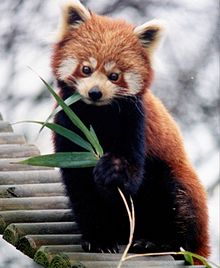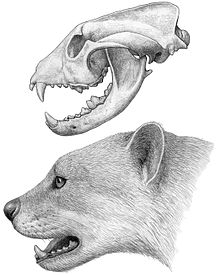วงศ์แพนด้าแดง
วงศ์แพนด้าแดง (ชื่อวิทยาศาสตร์: Ailuridae, /ไอ-เลอ-ริ-ดี/) เป็นวงศ์หนึ่งของสัตว์เลี้ยงลูกด้วยนมในอันดับสัตว์กินเนื้อ ซึ่งมีเพียงสัตว์ชนิดเดียวเท่านั้นที่อยู่ในวงศ์นี้ คือ แพนด้าแดง นอกจากนี้คือญาติที่สูญพันธ์แล้ว
| วงศ์แพนด้าแดง ช่วงเวลาที่มีชีวิตอยู่: Oligocene–Recent | |
|---|---|

| |
| แพนด้าแดง (Ailurus fulgens) | |

| |
| หัวกะโหลกและภาพจำลองของ Simocyon | |
| การจำแนกชั้นทางวิทยาศาสตร์ | |
| โดเมน: | ยูแคริโอตา |
| อาณาจักร: | สัตว์ |
| ไฟลัม: | สัตว์มีแกนสันหลัง |
| ชั้น: | สัตว์เลี้ยงลูกด้วยนม |
| อันดับ: | อันดับสัตว์กินเนื้อ |
| วงศ์ใหญ่: | Musteloidea |
| วงศ์: | วงศ์แพนด้าแดง Gray, 1843 |
| วงศ์ย่อย | |

| |
| แผนที่การกระจายพันธุ์ของแพนด้าแดง | |
ฌอร์ฌ กูวีเยร์ได้จัดให้แพนด้าแดงอยู่ในวงศ์แรคคูนใน ค.ศ. 1825 การจัดอันดับแบบนี้ก่อให้เกิดข้อถกเถียงนับแต่นั้นมา[1] สาเหตุเนื่องจากเห็นว่าแพนด้าแดง มีลักษณะทางกายภาพหลายอย่างที่เหมือนกับแรคคูน เช่น ลักษณะลำตัวสั้น มีหางยาว มีรูปหน้า และลวดลายคล้ายกับแรคคูน นอกจากนั้นยังมีพฤติกรรมการออกหากินในช่วงเวลากลางคืน และใช้เวลาส่วนใหญ่อาศัยอยู่บนต้นไม้คล้ายกับแรคคูนอีกด้วย หรือแม้แต่บางคนก็จัดให้อยู่วงศ์เดียวกันกับหมี[2]
การศึกษาวิวัฒนาการชาติพันธุ์ระดับโมเลกุลแสดงให้เห็นว่า แพนด้าแดง ในฐานะสัตว์ชนิดโบราณในอันดับสัตว์กินเนื้อ มีความใกล้ชิดกับแรคคูนอเมริกัน และอาจเป็นวงศ์หรือวงศ์ย่อยชนิดเดียวในวงศ์ procyonid[1][3][4] การศึกษาวิเคราะห์ดีเอ็นเอของไมโทคอนเดรียของประชากรเชิงลึกระบุว่า: "ตามบันทึกฟอสซิล แพนด้าแดงแยกออกจากบรรพบุรุษร่วมกันกับหมีเมื่อประมาณ 40 ล้านปีก่อน"[1][5]
ปัจจุบันแพนด้าแดงแบ่งออกเป็น 2 ชนิดย่อย คือ Ailurus fulgens fulgens ซึ่งมีขนาดตัวเล็ก และขนที่ใบหน้ามีสีจาง ส่วนใหญ่อาศัยอยู่ทางตอนเหนือของประเทศอินเดียในรัฐอัสสัมและสิขิม หรือประเทศภูฎาน, ประเทศเนปาล และบางส่วนของประเทศจีน ส่วนอีกชนิดย่อยหนึ่งคือ Ailurus fulgens styani มีขนาดตัวที่ใหญ่และมีลายที่หน้าสีเข้มกว่าชนิดย่อยแรก ซึ่งส่วนใหญ่อาศัยอยู่ในประเทศจีนแถบมณฑลยูนาน และเทือกเขาในมณฑลเสฉวน และทางตอนเหนือของประเทศพม่า อาหารหลักคือใบไผ่ บางครั้งอาจกินลูกสน, รากไม้, เห็ด , ไข่นก หรือลูกนก เป็นต้น ชอบออกหากินเวลาใกล้ค่ำ อาศัยอยู่บนต้นไม้เป็นส่วนใหญ่[6]
การจำแนก แก้
ความสัมพันธ์ในวงศ์แพนด้าแดงกับสัตว์กินเนื้อชนิดอื่นแสดงให้เห็นในต้นไม้วิวัฒนาการชาติพันธุ์ ซึ่งอิงจากการวิเคราะห์ความสัมพันธ์เชิงวิวัฒนาการในระดับโมเลกุลจากยีน 6 ยีนใน Flynn, 2005.[7]
| Carnivora |
| ||||||||||||||||||||||||||||||||||||||||||
นอกจาก Ailurus วงศ์แพนด้าแดงยังรวมสกุลที่สูญพันธ์แล้ว 7 สกุล ส่วนใหญ่จัดให้มี 3 วงศ์ย่อย: Amphictinae, Simocyoninae และ Ailurinae[8][9][10][11][12]
- วงศ์ Ailuridae J.E. Gray, 1843
- วงศ์ย่อย †Amphictinae ?Winge, 1896
- †Amphictis ?Pomel, 1853
- †Amphictis borbonica Viret, 1929
- †Amphictis ambigua (Gervais, 1872)
- †Amphictis milloquensis (Helbing, 1936)
- †Amphictis antiqua (de Blainville, 1842)
- †Amphictis schlosseri Heizmann & Morlo, 1994
- †Amphictis prolongata Morlo, 1996
- †Amphictis wintershofensis Roth, 1994
- †Amphictis cuspida Nagel, 2003
- †Amphictis timucua J.A. Baskin, 2017[13]
- †Amphictis ?Pomel, 1853
- วงศ์ย่อย †Simocyoninae Dawkins, 1868
- †Actiocyon Stock, 1947
- †Actiocyon parverratis Smith et al., 2016[14]
- †Actiocyon leardi Stock, 1947
- †Alopecocyon Camp & Vanderhoof, 1940
- †Alopecocyon getti Mein, 1958
- †Alopecocyon goeriachensis (Toula, 1884)
- †Protursus Crusafont & Kurtén, 1976
- †Protursus simpsoni Crusafont & Kurtén, 1976
- †Simocyon Wagner, 1858
- †Simocyon primigenius (Roth & Wagner, 1854)
- †Simocyon diaphorus (Kaup, 1832)
- †Simocyon batalleri Viret, 1929
- †Simocyon hungaricus Kadic & Kretzoi, 1927
- †Actiocyon Stock, 1947
- วงศ์ย่อย Ailurinae J.E. Gray, 1843
- †Magerictis Ginsburg et al., 1997
- †Magerictis imperialensis Ginsburg et al., 1997
- Tribe Pristinailurini Wallace & Lyon, 2022
- †Pristinailurus Wallace & Wang, 2004
- †Pristinailurus bristoli Wallace & Wang, 2004
- †Parailurus Schlosser, 1899
- †Parailurus anglicus (Dawkins, 1888) [Parailurus hungaricus Kormos, 1935]
- †Parailurus tedfordi Wallace & Lyon, 2022
- †Parailurus baikalicus Sotnikova, 2008
- †Pristinailurus Wallace & Wang, 2004
- เผ่า Ailurini
- Ailurus F. Cuvier, 1825
- Ailurus fulgens - แพนด้าแดง
- Ailurus fulgens styani Thomas, 1902 – แพนด้าแดงตะวันออก
- Ailurus fulgens fulgens F. Cuvier, 1825 – แพนด้าแดงตะวันตก
- Ailurus fulgens - แพนด้าแดง
- Ailurus F. Cuvier, 1825
- †Magerictis Ginsburg et al., 1997
- วงศ์ย่อย †Amphictinae ?Winge, 1896
นอกจากนี้ หน่วยอนุกรมวิธานที่ไม่มีชื่อ แต่มีชื่อเรียกว่า "Ailurinae indet." ได้รับการระบุใน ค.ศ. 2001 โดยอิงจากฟันกรามส่วนบนจากสัตว์วงศ์แพนด้าแดง 4 ตัวในสมัยไมโอซีนตอนกลางใกล้อีแซร์ ประเทศฝรั่งเศส[15]
อ้างอิง แก้
- ↑ 1.0 1.1 1.2 Mayr, E. (1986). "Uncertainty in Science: is the Giant panda a bear or a raccoon?". Nature. 323 (6091): 769–771. Bibcode:1986Natur.323..769M. doi:10.1038/323769a0. PMID 3774006. S2CID 4317414.
- ↑ Roberts, M.S.; Gittleman, J.L. (1984). "Ailurus fulgens". Mammalian Species. American Society of Mammalogists (222): 1–8. doi:10.2307/3503840. JSTOR 3503840.
- ↑ Zhang, Y.P.; Ryder, O.A. (1993). "Mitochondrial DNA sequence evolution in the Arctoidea". PNAS. 90 (20): 9557–9561. Bibcode:1993PNAS...90.9557Z. doi:10.1073/pnas.90.20.9557. PMC 47608. PMID 8415740.
- ↑ Slattery, J.P.; O'Brien, S.J. (1995). "Molecular Phylogeny of the Red Panda (Ailurus fulgens)". J. Hered. 86 (6): 413–422. doi:10.1093/oxfordjournals.jhered.a111615. PMID 8568209.
- ↑ Bing, Su; Fu, Yunxin; Wang, Yingxiang; Jin, Li; Chakraborty, Ranajit (2001). "Genetic Diversity and Population History of the Red Panda (Ailurus fulgens) as Inferred from Mitochondrial DNA Sequence Variations". Molecular Biology and Evolution. 18 (6): 1070–1076. doi:10.1093/oxfordjournals.molbev.a003878. PMID 11371595.
- ↑ "แพนด้ายักษ์และแพนด้าแดงจัดเป็นหมีหรือไม่". คลังข้อมูลเก่าเก็บจากแหล่งเดิมเมื่อ 2014-03-11. สืบค้นเมื่อ 2013-08-17.
- ↑ Flynn, J.J.; Finarelli, J.A.; Zehr, S.; Hsu, J.; Nedbal, M.A. (2005). "Molecular phylogeny of the Carnivora (Mammalia): Assessing the impact of increased sampling on resolving enigmatic relationships". Systematic Biology. 54 (2): 317–337. doi:10.1080/10635150590923326. PMID 16012099.
- ↑ McKenna, M.C.; Bell, S.K. (1997). Classification of Mammals Above the Species Level. Columbia University Press. ISBN 9780231528535.[ต้องการเลขหน้า]
- ↑ Peigné, S.; Salesa, M.; Antón, M.; Morales, J. (2005). "Ailurid carnivoran mammal Simocyon from the late Miocene of Spain and the systematics of the genus" (PDF). Acta Palaeontologica Polonica. 50: 219–238.
- ↑ Salesa, M.; Antón, M.; Peigné, S.; Morales, J. (2006). "Evidence of a false thumb in a fossil carnivore clarifies the evolution of pandas". Proceedings of the National Academy of Sciences. 103 (2): 379–382. Bibcode:2006PNAS..103..379S. doi:10.1073/pnas.0504899102. PMC 1326154. PMID 16387860.
- ↑ Wallace, S.C.; Wang, X. (2004). "Two new carnivores from an unusual late Tertiary forest biota in eastern North America". Nature. 431 (7008): 556–559. Bibcode:2004Natur.431..556W. doi:10.1038/nature02819. PMID 15457257. S2CID 4432191.
- ↑ Morlo, Michael; Peigné, Stéphane (2010). "Molecular and morphological evidence for Ailuridae and a review of its genera". ใน Goswami, Anjali; Friscia, Anthony (บ.ก.). Carnivoran Evolution: New Views on Phylogeny, Form, and Function. pp. 92–140. doi:10.1017/CBO9781139193436.005. ISBN 978-0-521-73586-5.
- ↑ Baskin, Jon A. (2017). "Additional carnivorans from the early Hemingfordian Miller Local Fauna, Florida". Journal of Vertebrate Paleontology. 37 (2): e1293069. Bibcode:2017JVPal..37E3069B. doi:10.1080/02724634.2017.1293069. S2CID 90182619.
- ↑ Smith, Kent; Czaplewski, Nicholas; Cifelli, Richard (2016). "Middle Miocene carnivorans from the Monarch Mill Formation, Nevada". Acta Palaeontologica Polonica. 61 (1): 231–252. doi:10.4202/app.00111.2014.
- ↑ Ginsburg, Leonard; Maridet, Olivier; Mein, Pierre (2001). "Un Ailurinae (Mammalia, Carnivora, Ailuridae) dans le Miocène moyen de Four (Isère, France)" [An Ailurinae (Mammalia, Carnivora, Ailuridae) in the middle Miocene of Four (Isère, France)]. Geodiversitas (ภาษาฝรั่งเศส). 23 (1): 81–85.
อ่านเพิ่ม แก้
- Davis D. Dwight (1964). "The Giant Panda: A Morphological Study of Evolutionary Mechanisms". Zoology Memoirs. 3: 1–339.
- Decker D.M., Wozencraft W.C. (1991). "Phylogenetic Analysis of Recent Procyonid Genera". Journal of Mammalogy. 72 (1): 42–55. doi:10.2307/1381979. JSTOR 1381979.
- Flynn, J.J. and G.D. Wesley Hunt. (2005a). "Carnivora." in The Rise of Placental Mammals: Origin, Timing and Relationships of the Major Extant Clades, by D. Archibold and K. Rose. Baltimore. ISBN 0-8018-8022-X
- Flynn John J; และคณะ (2005b). "Molecular phylogeny of the Carnivora (Mammalia): ASS-ASS the impact of increased sampling to on resolving enigmatic relationships". Systematic Biology. 54 (2): 1–21. doi:10.1080/10635150590923326. PMID 16012099.
- Flynn, John J. Flynn, Michael A. Nedbal, J.W. Dragoo, and R.L. Honeycutt. (1998) "Whence the Red Panda?" Molecular Phylogenetics and Evolution. Vol. 17, No. 2, November 2000, pp. 190–199. [1]
- Glatston, A.R. (1989). Talk Panda Biology. The Hague. ISBN 90-5103-026-6
- Glatston, A.R. (compiler) (1994). "The Red Panda, Olingos, Coatis, Raccoons, and their Relatives: Status survey and conservation action plan for Procyonids and Ailurids."
- IUCN/SSC Mustelid, Viverrid, and Procyonid Specialist Group. IUCN/SSC, Gland, Switzerland.
- Gregory W.K. (1936). "On the Phylogenetic Relationships of the Giant Panda (Ailuropoda) to other Arctoid Carnivores". American Museum Novitates (878): 1–29.
- Hu, J.C. (1990). "Proceedings of studies of the red panda." Chinese Scientific Publishing, Beijing, China [in Chinese].
- Wilson, Don E. and DeeAnn M. Reeder. (2005). Mammal of Species of the World. Johns Hopkins University press. ISBN 0-8018-8221-4.